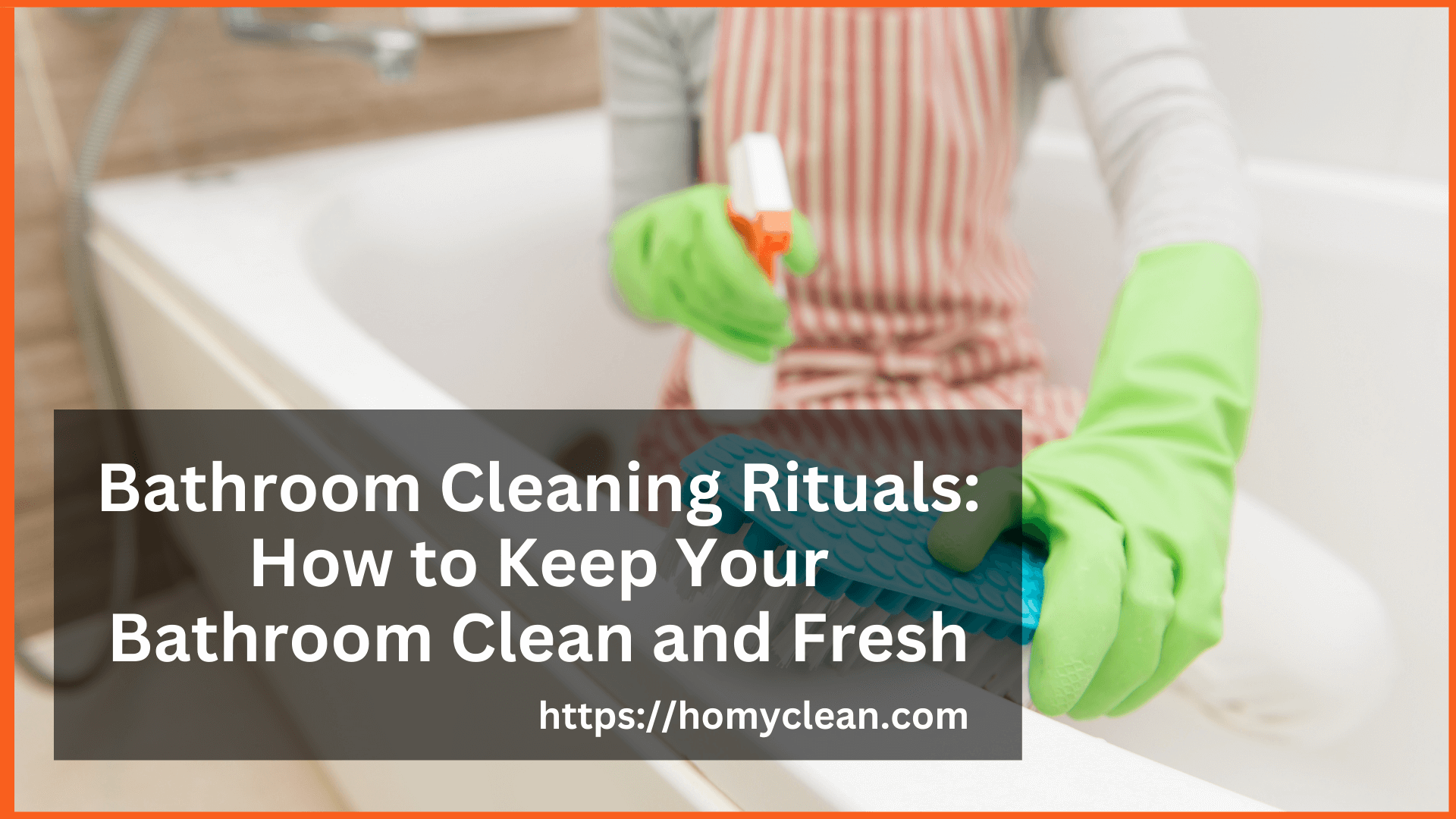Maintaining the impeccable appearance of a freestanding bath, synonymous with elegance and luxury in any bathroom, demands consistent cleaning and care. For those seeking guidance on “How to Clean Freestanding Bath,” this resource offers expert insights and practical suggestions to ensure your bath stays pristine, hygienic, and retains its brand-new allure. From indispensable cleaning supplies to correct cleaning methodologies, we’ve got you covered. Let’s explore the key aspects:
Step By Step Guide How to Clean Black Freestanding Bath
1. Gathering the Right Cleaning Supplies
To begin the cleaning process, it’s essential to have the right cleaning supplies at hand. Here are the items you’ll need:
- Soft Microfiber Cloth
- Non-Abrasive Cleaner
- White Vinegar:
- Baking Soda
- Spray Bottle
- Toothbrush
- Rubber Gloves
- Soft Dry Towels
2. Clearing the Area Around the Freestanding Bath
- Before starting the cleaning process, ensure the surrounding area of the bath is clear.
- Remove all bath accessories, mats, and personal items to facilitate easy access.
- Clearing the space beforehand ensures a comprehensive cleaning without any hindrances.
3. Preparing a Homemade Cleaning Solution
- Utilize natural cleaning solutions for an eco-friendly and efficient freestanding bath cleaning method.
- Mix equal parts of white vinegar and water in a spray bottle to create a potent cleaning solution.
- Apply the solution to effectively clean the freestanding bath without harmful chemicals.
4. Cleaning the Exterior of the Freestanding Bath
The exterior surface of the bath can accumulate dust, dirt, and even soap scum. Here’s how you can clean it effectively:
- Spray the vinegar and water mixture generously over the exterior surface of the bath.
- Use a soft microfiber cloth to wipe the surface in circular motions, removing grime and stains.
- Clean the bath’s legs, faucets, and other fixtures.
- Use a dry, soft towel to wipe away any excess moisture and give the bath a sparkling finish.
5. Cleaning the Interior of the Freestanding Bath
The bath interior is where you want to relax and unwind, so keeping it clean and inviting is crucial. Here’s how to do it:
- Pour a cup of white vinegar into a full bath of warm water.
- Let the bath sit for approximately 20 minutes to allow the vinegar to effectively address stains and limescale.
- Apply baking soda onto a damp cloth and delicately scrub the interior of the bath to eliminate any lingering stains or grime.
- Drain the water and thoroughly rinse the bath to ensure complete removal of vinegar and baking soda residues.
- Dry the bath using a soft towel for a final polished appearance.
6. Cleaning the Overflow Drain and Pop-up Waste
Often overlooked, the overflow drain and pop-up waste can accumulate dirt and debris over time. Follow these steps to clean them effectively:
- Twist or pull the design as needed for removal.
- Clean the pop-up waste cover with a toothbrush and soapy water to eliminate grime.
- Utilize a flexible brush or pipe cleaner to access the overflow drain and clear away any trapped debris.
- Rinse both the cover and overflow drain with water, ensuring thorough cleaning.
- Dry the components completely before reassembling the setup.
7. Removing Stubborn Stains and Limescale
Even with regular cleaning, stubborn stains, and limescale can appear on the surface of your freestanding bath. Don’t worry; we have a solution:
- Create a dense mixture by blending baking soda with water.
- Apply the resulting baking soda paste onto stained regions and limescale buildups.
- Allow the paste to sit for a minimum of 30 minutes to ensure effective stain removal.
- Utilize a gentle brush or cloth to scrub stained areas using circular motions.
- Thoroughly rinse the bath to eliminate all remnants of the paste and unveil a spotless surface.
8. Addressing Hard Water Stains
If your area has hard water, you might notice unsightly hard water stains on your freestanding bath. Here’s how to tackle them:
- Prepare a warm water bath and introduce a blend of equal parts vinegar and water.
- Allow the bath to soak overnight for the breakdown of mineral deposits causing hard water stains.
- Employ a gentle brush or cloth to remove the softened stains the following day.
- Drain the water and thoroughly rinse the bath to eliminate all remnants of vinegar and mineral deposits.
9. Dealing with Soap Scum
Soap scum can accumulate on the surface of your freestanding bath, giving it a dull and dirty appearance. Follow these steps to combat soap scum:
- Mix baking soda with a small amount of water to form a paste.
- Apply the baking soda paste to the soap scum areas.
- To break down the soap scum, give the paste around 15 minutes to sit.
- Use a soft brush or cloth to scrub away the soap scum without damaging the bath surface.
- Rinse the bath to reveal a clean, soap-scum-free surface.
Related Topic: How to Clean Bathtub Drain
How To Maintain and Clean Freestanding Bath Regularly
Regular maintenance is essential to keeping a freestanding bath looking its best. Here are some maintenance tips:
- Perform daily wiping of both the exterior and interior of the bath using a soft microfiber cloth to prevent dust and grime accumulation.
- Conduct a thorough deep cleaning session to eliminate stubborn stains, soap scum, and limescale.
- Utilize mild, non-abrasive cleaners to avoid potential damage to the bath’s surface.
- After each use, ensure the bath is dried with a soft towel to prevent water spots and mineral buildup.
- Place bath mats both inside and outside the bath to prevent slipping and protect the floor from water splashes.
- Regularly clean the overflow drain and pop-up waste to prevent clogs and buildup.
- Periodically polish metal fixtures such as faucets and drains to maintain their shine.
- Handle freestanding baths with care, avoiding any harsh impacts that may cause damage.
How to Deal with Rust Stains
Rust stains are common, especially if metal fixtures are around a freestanding bath. Here’s how to handle them:
- Create a paste by combining lemon juice and table salt.
- Apply the lemon juice paste directly onto the rust stains.
- Allow the paste to sit for approximately an hour to absorb the stains.
- Gently scrub away the rust stains using a soft brush or cloth.
- Thoroughly rinse the bath to eliminate any remnants of the lemon juice.
- Dry the bath and polish any metal fixtures to deter future rusting.
How to Prevent Mildew and Mold Growth
Mildew and mold can thrive in damp environments, making the bathroom susceptible. Here’s how to prevent their growth:
- Maintain proper ventilation in your bathroom to minimize humidity and moisture.
- After each use, wipe the interior of the bath to eliminate moisture.
- Use mold-resistant caulk around the edges of the bath to inhibit mold growth.
- Employ a dehumidifier in humid bathrooms to manage moisture levels.
How to Address Scratches and Surface Damage of Freestanding Bath
Over time, your freestanding bath may develop minor scratches and surface damage. Here’s how to address them:
- Use fine-grit sandpaper to buff out minor scratches gently.
- Apply a polishing compound to restore the bath’s shine.
- Consider using a bath repair kit for more significant surface damage.
Natural Cleaners for Eco-Friendly Cleaning Freestanding Bath
If you prefer eco-friendly cleaning options, consider using these natural cleaners:
- Baking Soda: Effective for removing stains and deodorizing the bath.
- White Vinegar: A natural disinfectant that can remove grime and limescale.
- Lemon Juice: Helps remove rust stains and adds a fresh scent.
- Essential Oils: Add a few drops of essential oils to your cleaning solution for a pleasant aroma.
How to Use Steam Cleaners for Deep Cleaning Freestanding Bath
Steam cleaners can provide a deep and thorough cleaning of your freestanding bath. Here’s how to use them:
- Fill the steam cleaner with water and the appropriate cleaning solution as recommended.
- Preheat the steam cleaner following the manufacturer’s instructions.
- Hold the nozzle of the steam cleaner near the surface of the bath and clean it section by section.
- Employ a microfiber cloth to eliminate dirt and moisture while steaming.
- After steam cleaning, ensure thorough drying of the bath.
Cleaning Different Freestanding Bath Materials
Depending on the material of your freestanding bath, you’ll need to adapt your cleaning approach:
- Acrylic Baths: Use a non-abrasive cleaner to avoid scratching the acrylic surface.
- Stone Resin Baths: Avoid harsh chemicals that may damage the stone resin material.
- Cast Iron Baths: Use mild cleaners and avoid abrasive scrubbing.
- Copper Baths: Polish copper baths regularly to maintain their natural shine.
How to Organize and Clean Freestanding Bath Supplies for Easy Access
- Establish a dedicated storage area for cleaning supplies to enhance efficiency.
- Utilize caddies or baskets to organize and easily access cleaning materials.
- Optimize the cleaning process by creating a designated space for supplies.
How to Set Up a Freestanding Bath Cleaning Schedule
- Establish a consistent cleaning schedule for your freestanding bath to effortlessly maintain its cleanliness.
- Create a weekly or bi-weekly routine to ensure your bath remains immaculate and welcoming.
- Implementing a regular cleaning schedule will make it easier to keep your freestanding bath spotless.
- Ensure the cleanliness of your bath by adhering to a consistent cleaning routine either weekly or bi-weekly.
- Maintain the inviting allure of your freestanding bath with a systematic cleaning schedule.
- Keep your bath spotless and appealing by incorporating a regular cleaning routine into your schedule.
- Make the task of maintaining a clean freestanding bath easier by establishing a weekly or bi-weekly cleaning regimen.
- Implementing a consistent cleaning schedule is key to ensuring your freestanding bath stays inviting and pristine.
- Adhere to a routine cleaning schedule to effortlessly preserve the cleanliness of your freestanding bath.
- Enhance the cleanliness and appeal of your bath by following a weekly or bi-weekly cleaning routine.
What to Avoid When Cleaning Freestanding Bath
While cleaning your freestanding bath, be mindful of the following:
- Avoid using abrasive cleaners that can scratch the bath’s surface.
- Never use steel wool or harsh scouring pads, as they can damage the bath’s finish.
- Avoid using bleach on colored baths, as it may cause fading.
Recommended Topics:
Frequently Asked Questions (FAQs)
Can I use bleach to clean my freestanding bath?
While bleach can be effective, it’s not recommended for colored baths as it may cause discoloration. Stick to mild, non-abrasive cleaners instead.
How often should I deep clean my freestanding bath?
For regular maintenance, deep clean your bath at least once a week to prevent the buildup of grime and stain
Is it safe to use a steam cleaner in my bath?
Yes, steam cleaners are safe to use on most bath materials. Follow the manufacturer’s instructions and ensure the bath is dry after steam cleaning.
Can I use essential oils in my cleaning solution?
Yes, essential oils not only add a pleasant aroma but can also provide additional cleaning properties. Just a few drops will do.
How do I remove rust stains from my freestanding bath?
Create a paste with lemon juice and table salt, apply it to the stains, let it sit for an hour, and then gently scrub away the rust.
What should I do if my bath has surface damage?
For minor scratches, use fine-grit sandpaper and polish. Consider a repair kit for more significant damage.
Conclusion
Maintaining a clean freestanding bath is achievable with the proper cleaning techniques and regular care. By using the proper cleaning supplies and adopting eco-friendly options, you can keep your bath pristine for years. Addressing issues like rust stains, hard water deposits, and soap scum ensures your bath is inviting and hygienic.
Avoid harsh chemicals and abrasive tools, and use natural cleaners whenever possible. Your freestanding bath can become a beloved bathroom focal point and a source of elegance and relaxation if you maintain a well-organized cleaning schedule.





